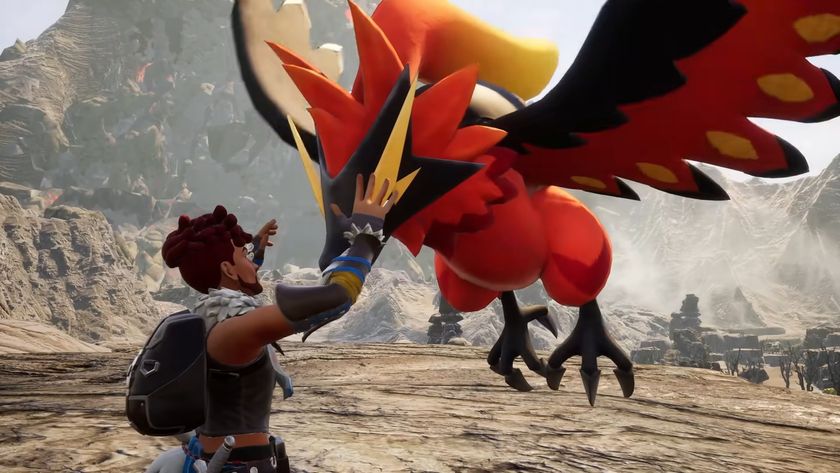The Lord of the Rings: Battle for Middle-Earth
The films may be over but, says PC Gamer, the true battle for Middle-Earth has yet to begin
While the screenshots speak for themselves, if you talk to the developers of this Tolkien-based RTS, the buzzword that gushes from their lips is "emotionality". Try to control your nausea. The idea is to take the experience of combat, then try to convey to the player the internal journey the protagonists are experiencing. That is: "Hurrah! We've kicked some orcish posterior! Down to the Nazgul's Arms, I'm buying." Or, of course: "Erk. I appear to be the entree on a Mordor menu."
"Way back in Red Alert 2," Executive Producer Mark Skaggs tells us, "we were talking about personality in everything. Now when I look back at that, I see the seeds of where we are today. But we didn't know back then."
The results in-game seem to be abstractly small, yet still powerful and charming. For example, individual soldiers possess a contextual awareness that's unprecedented in the genre. While in most games a group of soldiers will loop through their 'idle' animation until taken firmly under your control, in Battle for Middle-Earth they'll become aware that an opposing unit is in their vicinity and mock and jeer in preparation for fisticuffs. Once battle is joined, they'll pair up and fight in the manner of Rome: Total War. However, once the day is won the over-excited troops will loudly celebrate their victory, being overcome with excitement until you next take them in hand.
It's a different story when the situation looks more dicey. When a towering troll lurches towards the lines, foot soldiers will flinch and back away in fear before a blow from its tree-branch weapon is even struck. When it is, it will send them flying in all directions. Interestingly, however, in Battle for Middle-Earth the larger creatures have to actually gather their tools, tearing a tree from the ground to use to boost their combat skills. Naturally, the forest-guarding Ents won't indulge in such acts of vandalism, preferring to lob boulders to wreak their vengeance.
The emotional responses aren't just for the two-legged ones, either - you'll see similar actions with the larger beasts, varying according to their intelligence. So, for example, while a Mumakil, the monstrous Mordor mammoth, when set on fire will run wild in pain and fury, an even more flammable Ent will lumber screaming to a nearby water source to attempt to douse itself.
While this multitude of visual details brings the world to life, with everything from characters to locations faithfully recreated from the film, what's really interesting is what you get to do with this stuff which isn't in the film. The heart of the game is the set of single-player campaigns, where you recreate the events of the War of the Ring. While the exact details are still to be revealed, it's more than a linear sequence of battles. While certain touch-points such as the breaking of the Fellowship and the Battle of Minas Tirith must occur, the battles you choose to fight along the way are promised to vary wildly.
Sign up to the 12DOVE Newsletter
Weekly digests, tales from the communities you love, and more
Or be something entirely different. New Line Cinema have been the model of a modern videogame licensee and allowed EA considerable latitude. For example, not only are you able to play through a campaign which places you as the floating red eye upon Mount Doom... but you're able to actually win. That'll wipe the smug smile off those hobbits' faces. Also, on a smaller level, there's the possibility of certain troop types being moved from their home locations. Things could have been very different for the Alliance of Men if a Balrog turned up at Helm's Deep.
Despite visual comparisons to the Total War games - the large-scale battles, mainly - it's worth noting that this isn't a wargame, but much closer to a traditional RTS. Resources must be gathered to pay for your hordes, though this is relatively streamlined, with gold accumulating from your economic actions. These actions vary radically depending on which side you're playing. Deforestation, being frowned upon by Treebeard, is the way forward for the spawn of Mordor, while farming is much more acceptable to the Fellowship. Nice touches abound, however, with a more realistic technical advance system being especially interesting. For example, upgrading archers with flaming arrows isn't immediate. A heavily laden cart must make its way from your settlement to them, requiring protection along the way.
At this stage, much remains to clarified. While the videos show huge armies to boast what scale the technology can actually support - and this C&C: Generals-based tech is hugely impressive - it's clear that this isn't going to be what's on screen. While a final figure is still being decided upon, that will balance atmospheric and control issues, a thousand troops is cited as a good guess. Much larger than most RTSes, then, but considerably smaller than what you'd find in Total War. Appositely, the control mechanism for manipulating troops is to be placed at an intermediate point. While individual selections as in a traditional RTS game are absent, the small groupings you control are much more fluid than the big 100-man blocks we'll see when Total War once again takes the field.
In other words, LotR: The Battle for Middle-Earth seems to be a game that's trying to find its own place. While the recent Vivendi Middle-Earth RTS proved to be a mediocre cash-in, this seems to have every chance of living up to the potential of the source material. Now we're, ahem, Tolkien.
The Lord of the Rings: Battle for Middle-Earth is out on PC in the autumn












